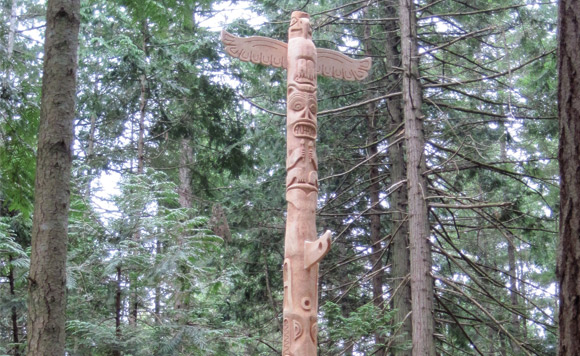by Trysh Ashby-Rolls –
Up and down the Northwest Pacific coast, from southeast Alaska to northern Washington State, you’ll find totem poles. Before Europeans came, bringing metal tools with them, totem poles were no bigger than walking canes. Their purpose was traditionally a representation of each family-clan’s life, although sometimes they were used as house posts and funerary containers; they were never objects of worship. According to Aldona Jonaitis, co-author of a book on totem poles, they are an “evolving form that is continually transforming.”
Haida Nation hereditary Chief James Hart, aka 7idansuu, is a master carver whose Reconciliation Pole was erected at UBC in April. It represents “victims and survivors of Canada’s residential school system, to bring attention to the destruction brought forth … And the effects we’re living with today,” Hart told CBC.
The 800-year-old cedar stands 17 metres tall and is studded with 68,000 nails – one for each child who died. At the base of the pole are the ghosts of those children. Above them is the protective family unit in full regalia “showing we’re getting back our strength.” Atop the pole is the eagle “taking off into the future.”
In March 2007, the community of Cordova, Alaska erected a Shame Pole. It represents an unpaid debt of $5 million a federal court in Anchorage awarded in punitive damages against ExxonMobil. Court determined that close to midnight on March 24, 1989, the Exxon Valdez slammed into a reef, gashing open the tanker’s single hull. 42 million litres of crude oil contaminated 1,990 kilometres of shoreline, killing birds and mammals, wrecking the natural beauty of the area, marine ecosystems, lives and livelihoods. The community has not healed.
Author Jonaitis finds “the notion of poles as part of the healing process” fascinating. There is a totem pole in Vancouver “memorializing a young man killed in racial violence was not even native.” The italics are mine because there is a non-native man living in the southern Gulf Islands who created a Healing Pole. The carver, Gregory Franklin, prefers the name Story Pole.
Franklin spent 10 years building a home from scratch, only to have it accidentally burn to the ground mere weeks before the house-warming party. He lost everything. Weeks later a close friend was killed in front of him, then another revealed he had a terminal illness. A trauma counsellor advised Franklin write his life story. It didn’t help. Frustrated, he walked around his property looking at the trees, realizing how much he loved nature. The story pole, a concept at first, was born. Later, he intuitively recognized a western red cedar that looked the way he felt – damaged. “Unlike totem pole carvers, I left the pole in the standing upright position, its roots firmly in the soil.” Months of research lay ahead to create a knowledge base for his own creation. Not wanting to commit cultural appropriation, he invited the late Tsimshian master carver, Victor Reece, to his land. Reece gave the work his blessing. While Franklin carved, he grieved. “It took six weeks to flush out but it went through all the steps.” Each day he carved, he felt “incredible relief.”
Eight years on, the Story Pole stands at the end of the driveway to Gregory Franklin’s newly-built home. It receives hundreds of visitors annually to whom it gives healing and hope.
Sources: CBC The Early Edition, www.cbc.ca Apr 1, 2017. The Totem Pole: An Intercultural History by Aldona Jonaitis & Aaron Glass. Douglas & McIntyre (2010). Totem Poles: Myth and Fact by Heather Ramsay. March 31, 2011. www.TheTyee.ca.




